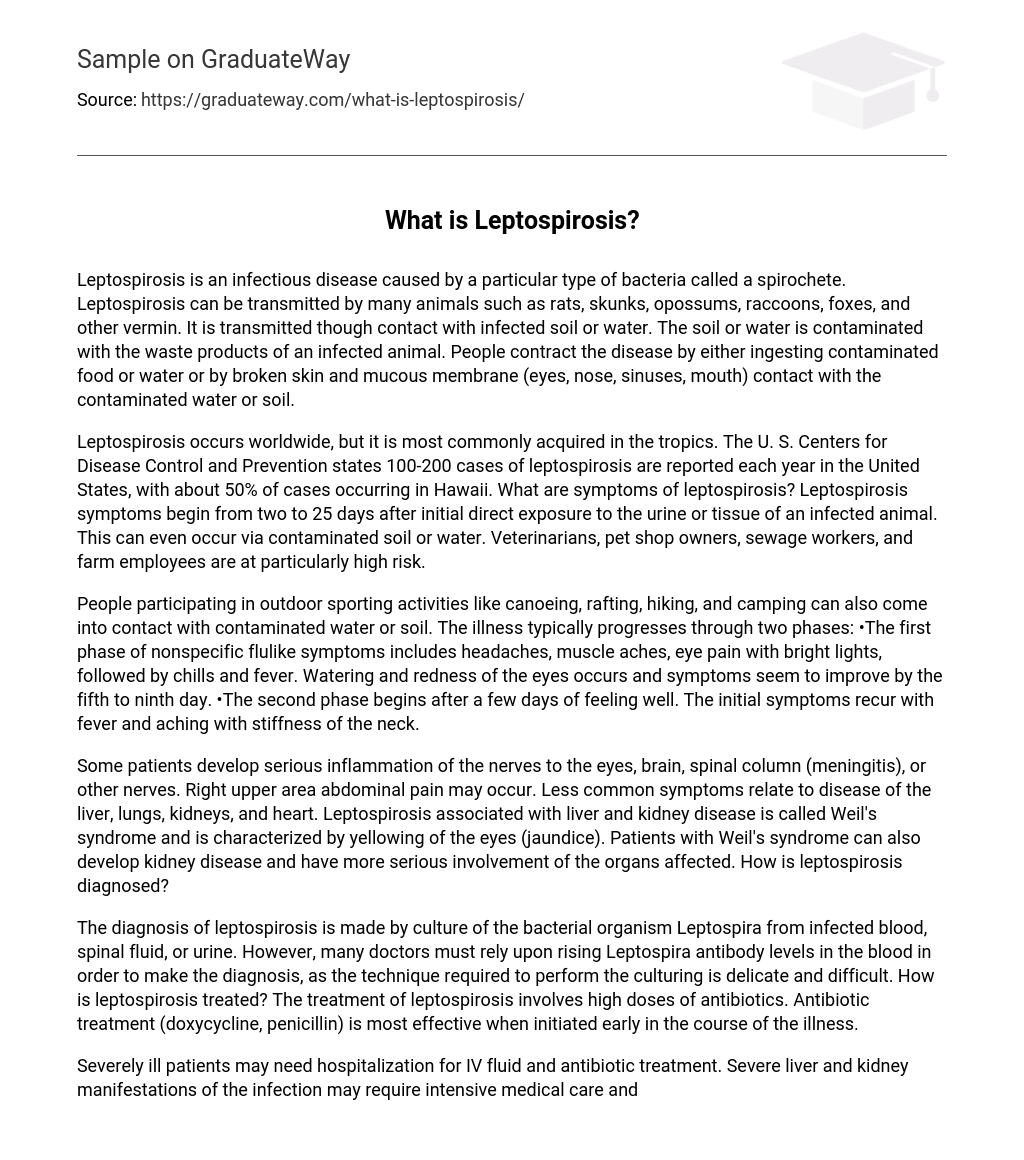Leptospirosis is an infectious disease caused by a particular type of bacteria called a spirochete. Leptospirosis can be transmitted by many animals such as rats, skunks, opossums, raccoons, foxes, and other vermin. It is transmitted though contact with infected soil or water. The soil or water is contaminated with the waste products of an infected animal. People contract the disease by either ingesting contaminated food or water or by broken skin and mucous membrane (eyes, nose, sinuses, mouth) contact with the contaminated water or soil.
Leptospirosis occurs worldwide, but it is most commonly acquired in the tropics. The U. S. Centers for Disease Control and Prevention states 100-200 cases of leptospirosis are reported each year in the United States, with about 50% of cases occurring in Hawaii. What are symptoms of leptospirosis? Leptospirosis symptoms begin from two to 25 days after initial direct exposure to the urine or tissue of an infected animal. This can even occur via contaminated soil or water. Veterinarians, pet shop owners, sewage workers, and farm employees are at particularly high risk.
People participating in outdoor sporting activities like canoeing, rafting, hiking, and camping can also come into contact with contaminated water or soil. The illness typically progresses through two phases: •The first phase of nonspecific flulike symptoms includes headaches, muscle aches, eye pain with bright lights, followed by chills and fever. Watering and redness of the eyes occurs and symptoms seem to improve by the fifth to ninth day. •The second phase begins after a few days of feeling well. The initial symptoms recur with fever and aching with stiffness of the neck.
Some patients develop serious inflammation of the nerves to the eyes, brain, spinal column (meningitis), or other nerves. Right upper area abdominal pain may occur. Less common symptoms relate to disease of the liver, lungs, kidneys, and heart. Leptospirosis associated with liver and kidney disease is called Weil’s syndrome and is characterized by yellowing of the eyes (jaundice). Patients with Weil’s syndrome can also develop kidney disease and have more serious involvement of the organs affected. How is leptospirosis diagnosed?
The diagnosis of leptospirosis is made by culture of the bacterial organism Leptospira from infected blood, spinal fluid, or urine. However, many doctors must rely upon rising Leptospira antibody levels in the blood in order to make the diagnosis, as the technique required to perform the culturing is delicate and difficult. How is leptospirosis treated? The treatment of leptospirosis involves high doses of antibiotics. Antibiotic treatment (doxycycline, penicillin) is most effective when initiated early in the course of the illness.
Severely ill patients may need hospitalization for IV fluid and antibiotic treatment. Severe liver and kidney manifestations of the infection may require intensive medical care and sometimes dialysis treatment. However, even in severe cases, liver and kidney function often does return after recovery from the illness. Mortality rates for severe illness with leptospirosis can range from 5%-40%, depending on the severity of organ dysfunction and the patient’s general health prior to infection. Most previously healthy patients will make a full recovery.
A vaccine for leptospirosis is available and used in Europe and Asia. It must be given every year like a flu shot. It is not currently available in the United States. Travelers who are going to an area where leptospirosis is common and who will be engaged in activities that increase likelihood of exposure, can take 200 mg of doxycyline per week by mouth starting before and during the time period of potential exposure. Leptospirosis was a reportable disease in the United States, but it was removed from the national CDC list of reportable diseases.
It is, however, still reportable in some states, most notably Hawaii. Can my pets get leptospirosis? According to the CDC, your pets (especially dogs, less commonly cats) can contract leptospirosis. Your pet can contract it in the same ways you can (ingesting contaminated soil, water or through skin wounds). Your pet may exhibit vomiting, refusal to eat, weight loss, decreased activity, muscle pains, or stiffness. If you suspect your pet is ill, take them to a veterinarian for testing and treatment. Early antibiotic treatment often can limit or prevent organ damage.
If your pet is diagnosed with leptospirosis, you must be careful to try to prevent exposure to yourself or other household members. Remember to wash your hands frequently with soap and water after cleaning up waste from your pet. If possible, use latex or rubber gloves to do the job of clean up. Use a diluted (1:10 parts) bleach solution to clean surfaces where pet wastes may have contaminated. And make sure your pet receives the full course of antibiotic treatment that is prescribed by your vet. Discuss other pet-care issues directly with your vet should you have any other questions regarding the disease.
Leptospirosis At A Glance •Leptospirosis is an infectious disease caused by a bacterium. •Leptospirosis is transmitted to humans by direct exposure to urine or tissue of an infected animal. •Leptospirosis typically progresses through two phases of nonspecific symptoms. •Leptospirosis can be diagnosed by culture of infected blood, urine, or spinal fluid, as well as using antibody testing. •Your pets may also be at risk for contracting leptospirosis. •Leptospirosis is treated with antibiotics and is rarely fatal.





